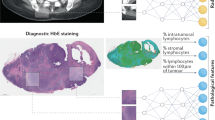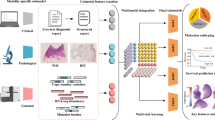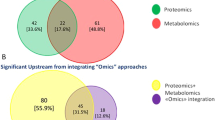Abstract
With the rapid technological advances in acquiring data from diverse platforms in cancer research, numerous large scale omics and imaging data sets have become available, providing high-resolution views and multifaceted descriptions of biological systems. Simultaneous analysis of such multimodal data sets is an important task in integrative systems biology. The main challenge here is how to integrate them to extract relevant and meaningful information for a given problem. The multimodal data contains more information and the combination of multimodal data may potentially provide a more complete and discriminatory description of the intrinsic characteristics of pattern by producing improved system performance than individual modalities. In this regard, some recent advances in multimodal big data analysis for cancer diagnosis are reported in this article.




Similar content being viewed by others
References
Barrenas F, Chavali S, Holme P, Mobini R, Benson M (2009) Network properties of complex human disease genes identified through genome-wide association studies. PLoS ONE 4(11):e8090
Chen J, Aronow B, Jegga A (2009) Disease candidate gene identification and prioritization using protein interaction networks. BMC Bioinform 10(1):73
Cox Robert W (1996) AFNI: software for analysis and visualization of functional magnetic resonance neuroimages. Comput Biomed Res 29:162–173
Goh K, Cusick ME, Valle D, Childs B, Vidal M, Barabisi AL (2007) The human disease network. Proc Natl Acad Sci USA 104(21):8685–8690
Golugula A, Lee G, Master SR, Feldman MD, Tomaszewski JE, Speicher DW, Madabhushi A (2011) Supervised regularized canonical correlation analysis: integrating histologic and proteomic measurements for predicting biochemical recurrence following prostate surgery. BMC Bioinform 12:483
Hotelling H (1936) Relations between two sets of variates. Biometrika 28(3/4):321–377
Iglesias Juan Eugenio, Liu Cheng-Yi, Thompson Paul M, Tu Zhuowen (2011) Robust brain extraction across datasets and comparison with publicly available methods. IEEE Trans Med Imaging 30(9):1617–1634
Kohler S, Bauer S, Horn D, Robinson PN (2008) Walking the interactome for prioritization of candidate disease genes. Am J Hum Genet 82(4):949–958
Maji P, Mandal A (2016) Rough hypercuboid based supervised regularized canonical correlation for multimodal data analysis. Fundam Inform 148(1–2):133–155
Maji P, Mandal A (2017) Multimodal omics data integration using max relevance-max significance criterion. IEEE Trans Biomed Eng 64(8):1841–1851
Maji P, Shah E (2017) Significance and functional similarity for identification of disease genes. IEEE/ACM Trans Comput Biol Bioinform 14(6):1419–1433
Maji P, Shah E, Paul S (2017) RelSim: an integrated method to identify disease genes using gene expression profiles and PPIN based similarity measure. Inf Sci 384:110–125
Mandal A, Maji P (2018) FaRoC: fast and robust supervised canonical correlation analysis for multimodal omics data. IEEE Trans Cybern 48(4):1229–1241
Navlakha S, Kingsford C (2010) The power of protein interaction networks for associating genes with diseases. Bioinformatics 26(8):1057–1063
Oti M, Snel B, Huynen MA, Brunner HG (2006) Predicting disease genes using protein-protein interactions. J Med Genet 43(8):691–698
Pelengaris S, Khan M (2013) The molecular biology of cancer: a bridge from bench to bedside, 2nd edn. Wiley, Hoboken
Roy S, Maji P (2018) An accurate and robust skull stripping method for 3-D magnetic resonance brain images. Magn Reson Imaging 54:46–57
Smith Stephen M (2002) Fast robust automated brain extraction. Hum Brain Mapp 17:143–155
Vinod HD (1976) Canonical ridge and econometrics of joint production. J Econom 4(2):147–166
Zhao J, Jiang P, Zhang W (2010) Molecular networks for the study of TCM pharmacology. Brief Bioinform 11(4):417–430
Acknowledgements
This work is an outcome of the R&D work undertaken in the project under the Visvesvaraya PhD Scheme of Ministry of Electronics and Information Technology, Government of India, being implemented by Digital India Corporation (formerly Media Lab Asia). The author would like to thank Ankita Mandal, Ekta Shah and Shaswati Roy of Indian Statistical Institute, Kolkata, India for providing helpful and valuable criticisms.
Author information
Authors and Affiliations
Corresponding author
Rights and permissions
About this article
Cite this article
Maji, P. Recent advances in multimodal big data analysis for cancer diagnosis. CSIT 7, 227–231 (2019). https://doi.org/10.1007/s40012-019-00236-9
Received:
Accepted:
Published:
Issue Date:
DOI: https://doi.org/10.1007/s40012-019-00236-9




